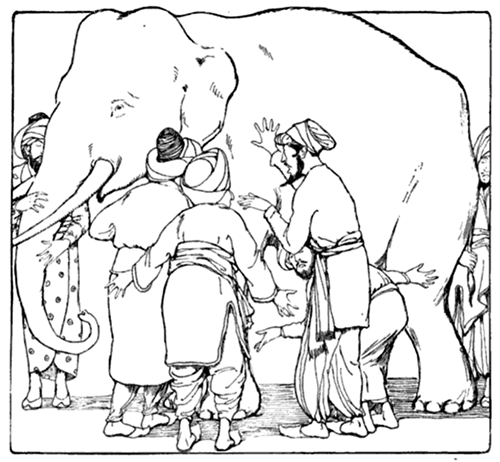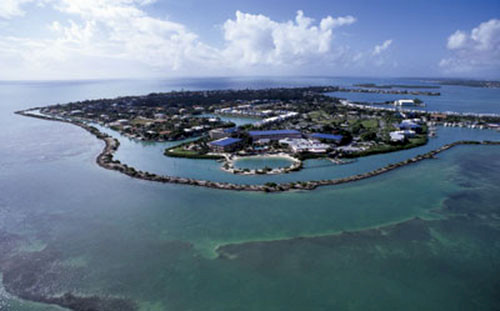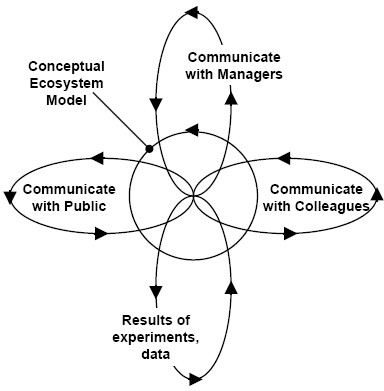What must the elephants be thinking?
Bill Nuttle ·Summary: Perhaps the best way to solve the problem of linking ecosystem science and management is to recognize the social dimensions of ecosystem science.
There were enough pachyderms parading around the Florida Keys Science Conference, last October, to fill center ring at the Ringling Brothers Circus. They were all over the place. Of course, everyone's attention was on the allegorical elephants, as the assembled scientists, half-blind and groping, attempted to describe the current state of the marine ecosystem. Quite a few other elephants lurked about, which nobody wanted to talk about, such as population growth in the region and rising sea level. The room was packed.

The conference's theme, "Linking Science to Management," is also a central concern in implementing ecosystem-based management, as called for in the new U.S. national ocean policy [1, 2]. This conference marked the 20th anniversary of the Florida Keys National Marine Sanctuary, which has been a proving ground for ecosystem-based management and related techniques for marine spatial planning. It is widely held that linking the distinctly separate realms that scientists and managers inhabit is a relatively new endeavor, and one that requires special attention to transmitting knowledge and to developing analytical tools for decision-making by managers, c.f. [3]. The elephants were metaphors for problems that must be overcome in forging this link, e.g. dealing with uncertainties inherent in scientific results and indecision over how to approach the potential consequences of global change.

I was attending to participate in a panel discussion, at the end of the conference, on techniques that can be used to link science and management more effectively. To help prepare for this role, I decided to attend and listen carefully to all of the presentations, beginning from the very start of the agenda, so that I would be up-to-date on the latest research results. This proved to be a great idea, at least at first. The presentations were uniformly good, and they stimulated my thinking about what comments I might make in the concluding discussion.
However, as time went on it got more and more difficult to ignore the growing number of elephants. At some point I asked myself, "What must the elephants be thinking?" Suppose that in the audience there is a sentient being with no knowledge of the Florida Keys, marine ecology, or even human language – what sense would it make of the conference proceedings? How would this being perceive the different realms of ecosystem scientists and managers? What would it suggest we do to link science and management together?
Of course, it is impossible for us humans to know, really, what an elephant would think in such a situation, but we can make an educated guess. Elephants are very intelligent, very social animals. Therefore, it is likely that an elephant in the auditorium at the Florida Keys science conference would instinctively set its mind to sorting out the social dynamics of the human herd corralled together by the meeting.
As it turns out, this is the approach that is taken by humans who engage in "science studies." The field of science studies attracts anthropologists, sociologists, historians and philosophers who examine the sociological aspects of science and technology. That is, they study what scientists and engineers actually do, and whom they do it with, rather than focusing mainly on the principles and ideas that guide these activities.
How would a practitioner of science studies, standing in for my elephant, have viewed the proceedings of the Florida Keys science conference? Bruno Latour, a leader in the field, describes science in terms of the circulation of ideas back and forth along different loops.[4] One loop links the researchers, through data and experiments, with their object of study. A second loop links researchers with their scientific colleagues, who must review their findings. A third loop links researchers with allies, i.e. managers, who rely on the results of their work. A fourth loop links researchers with the public, who must understand what is being learned and its consequences. Certainly, I could see evidence for these types of information circulating at the conference.

A critical fifth loop holds it all together. This loop assembles information flowing in the other four loops, raw data, peer review, application of the results, and its consequences, into a single coherent account, a shared vision. In ecosystem science, the fifth loop corresponds to the process of articulating a conceptual model of the ecosystem, c.f. [5, 6]. Coincidently, this was the topic of my comments at the panel discussion at the conclusion of the conference.
A remarkable thing happens when one looks at ecosystem science from Latour's perspective, as I imagine one of our elephants in the room might do. The separate realms of science and management disappear. Instead of being a largely isolated, and isolating, pursuit of "the truth" by specialists, ecosystem science becomes a collaborative enterprise that links together communities of scientists, managers, and the public. Uncertainty and indecision remain, but these are simply part of what we experience in any human endeavor. The whole is knit together by a back and forth exchange of ideas. The objective is to build a shared understanding and a shared vision of the places where we live.
References:
1. Lubchenco, J., and N. Sutley, 2010. Proposed US policy for ocean, coast and Great Lakes stewardship. Science 328:1485-1486.
2. Stewardship of the Ocean, Our Coasts, and the Great Lakes. 19 July 2010. [online:http://www.whitehouse.gov/the-press-office/executive-order-stewardship-ocean-our-coasts-and-great-lakes (accessed 11 Nov 2010)]
3. Lubchenco, J. 1998. Entering the century of the environment: a new social contract for science. Science 279:491-497.
4. Chapter 3 in Latour, B., 1999. Pandora's Hope: Essays on the Reality of Science Studies. Harvard University Press, Cambridge, Mass.
5. Ogden, J.C., S.M. Davis, K.J. Jacobs, T. Barnes, and H.E. Fling, 2005. The use of conceptual ecological models to guide ecosystem restoration in South Florida. Wetlands 25:795-809.
6. Gentile,J.H., M.A. Harwell, W. Cropper Jr., C.C. Harwell, D. DeAngelis, S. Davis, J.C. Ogden, D. Lirman, 2001. Ecological conceptual models: a framework and case study on ecosystem management for South Florida sustainability. The Science of the Total Environment 27:231-253.